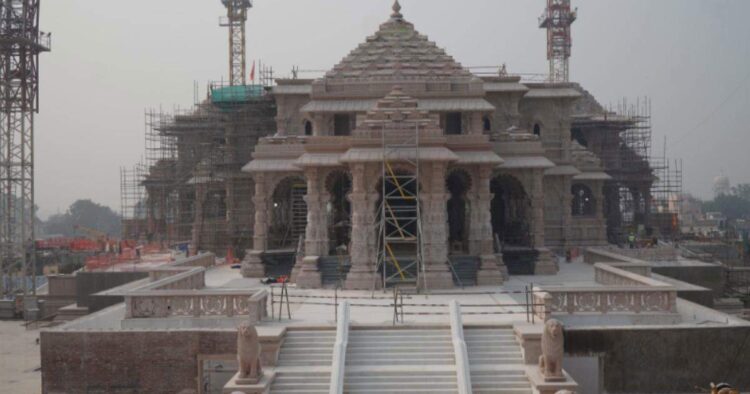Ayodhya, Bharat- The newly constructed grand temple dedicated to Ram Lalla, the child form of Lord Ram, stands as a remarkable fusion of traditional Bharat heritage architecture and cutting-edge construction science, designed to withstand the test of time for over a thousand years. The temple, situated on 2.7 acres with a built-up area of 57,000 square feet, has been meticulously crafted by top Bharat scientists, including contributions from ISRO technologies.
Chandrakant Sompura, a renowned architect with a lineage spanning 15 generations in designing heritage temple structures, employed Nagar Shaily or northern Bharat temple designs for the architectural blueprint. Described as a unique and splendid creation, the temple incorporates the very best quality granite, sandstone, and marble, omitting the use of cement or lime mortar in joints.
According to Shri Nripendra Misra, chairperson of the temple construction committee, the temple, soaring to a height of 161 feet (about 70% of the Qutab Minar), avoids the use of iron or steel, which typically has a lifespan of 80-90 years. Instead, a lock and key mechanism using grooves and ridges was implemented in the construction, ensuring longevity.
To overcome the challenge of unstable sandy ground near the Sarayu River, engineers excavated the soil to a depth of 15 meters and replaced it with an engineered soil. This was then complemented with a 1.5-meter-thick metal-free concrete raft for reinforcement, followed by a 6.3-meter-thick plinth of solid granite stone from southern Bharat.
The visible part of the temple, made of ‘Bansi Paharpur’ pink sandstone from Rajasthan, features 160 columns on the ground floor, 132 on the first floor, and 74 on the second floor, all intricately carved. The sanctum sanctorum is adorned with white Makrana marble from Rajasthan, reminiscent of the material used in the construction of the Taj Mahal.
The Central Building Research Institute (CBRI), actively involved in the project since early 2020, contributed significantly to the temple’s structural design, the ‘Surya Tilak’ mechanism, foundation vetting, and structural health monitoring. Dr. Sharda Srinivasan, an archaeologist, notes the temple’s adherence to traditional dry masonry methods, using interlocking grooves and pegs, while CBRI emphasizes the use of modern finite element analysis and sophisticated software tools in ensuring both performance and safety against seismic activity.
Dr. Pradeep Kumar Ramancharla, Director of CBRI, confidently asserts that the Ram Temple, rooted in heritage architecture, is defined by 21st-century building codes and cutting-edge technology. With the blend of tradition and innovation, it is anticipated to stand strong for more than a thousand years, a testament to the enduring spirit of cultural heritage and scientific progress.















Comments